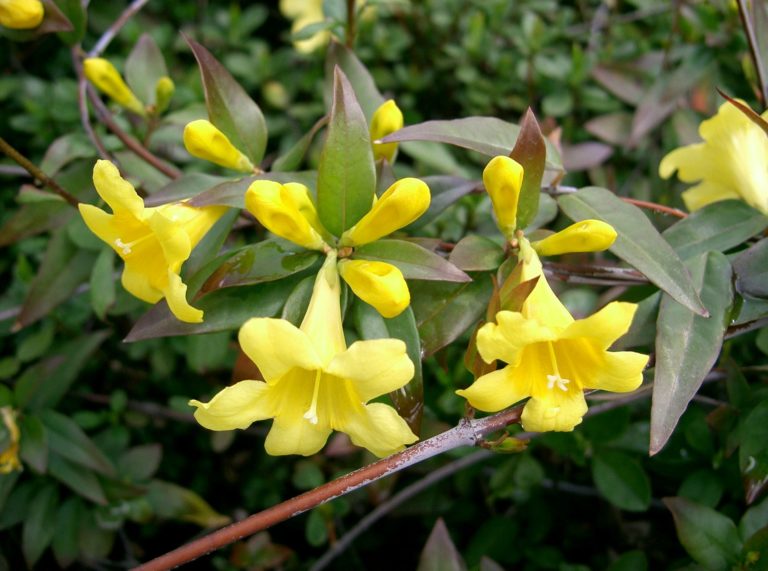Carolina Jessamine is a vigorous, evergreen, high-climbing woody vine native from Virginia to Florida, west to East Texas and down into Central America. It is a staple ornamental in the south because it has bright golden, fragrant flowers attractive to bees, butterflies and birds, including hummingbirds. Jassamine is a twining vine, 10-20′ high, or if unsupported it will cover the ground in bushy mounds. Growing on the ground it does not seem to flower (a plant physiologist’s graduate degree project!) but high in the trees along the roadsides or climbing a fence in the back yard in very early spring and sporadically thereafter, it is a delightful sight. Hardy and trouble free, it flowers profusely in the sun. However, be aware that all parts of this plant are toxic to humans, and also to European honeybees.
NURSERY HOURS
Wednesday: 10-4 Thursday: 10-6 Friday-Saturday: 10-4 Sunday: 12-4
Gelsemium sempervirens

Key Info
Scientific Name: Gelsemium sempervirens (L.) W.T. Aiton
Common Names: Carolina Jessamine, Carolina Jasmine, Yellow Jessamine, Evening Trumpetflower, Poor Man's Rope
Family Names: Gelsemiaceae
Plant Type: Vine
Leaf Retention: Semi-evergreen
Flower Color: Yellow
Additional Info
Habit: Twining vine to 20' with tap root and wiry reddish-brown stems. The leaves and flowers are borne on dwarf shoots. Without support, Jasmine grows as a groundcover and will mound up in bushy piles without flowering.
Height: 10-20'
Spread: 4-5'
Soil Conditions: Moist, well-drained, humus-rich soil, acidic (pH<6.8) to circumneutral (pH 6.8-7.2). Sandy, Sandy Loam, Medium Loam, Clay Loam, Clay.
Leaves: Simple, opposite, shiny, lanceolate, light green leaves (to 1-3” long) with acute tip, a rounded to wedge-shaped base and pinnate venation. Leaves are evergreen, but may develop yellow to purple/bronze hues in winter. Plants are only semi-evergreen toward the northern limits of their growing range (North Carolina).
Flowers (or reproductive structures: The fragrant flowers are axillary, trumpet-shaped (radially symmetrical) with 5 fused petals, five sepals, 5 stamens attached to the lower part of the corolla tube. They are bright yellow, either single or or in clusters (cymes), in late winter to early spring (February – April). Individual plants are self-incompatible and a second plant is needed for fertilization and seed formation.
Fruit: The fruit is a persistent, 1½ inch, dry, brown, laterally compressed or flattened dehiscent capsule,
Natural Distribution: Dry to wet thickets, woods, fence rows, roadsides.
USDA Hardiness Zone: 7-10
USDA Wetland Indicator Status in NC: FAC (FACU in Atlantic and Gulf Coastal Plain )
Pollination: Jessamine is a heterostylous species, meaning that the arrangement of flower parts differs from plant to plant in such a way as to allow fertilization only if the pollen is from a plant with a differing arrangement of floral parts (not self). The critters involved in pollen transfer are bees, butterflies and hummingbirds.
Wildlife Connections: Attracts butterflies (including the Spicebush Swallowtail Butterfly), hummingbirds, and bees. The toxicity of the tissues is consistent with reports of deer resistance.
Propagation: Gelsemium is easily propagated from cuttings.
